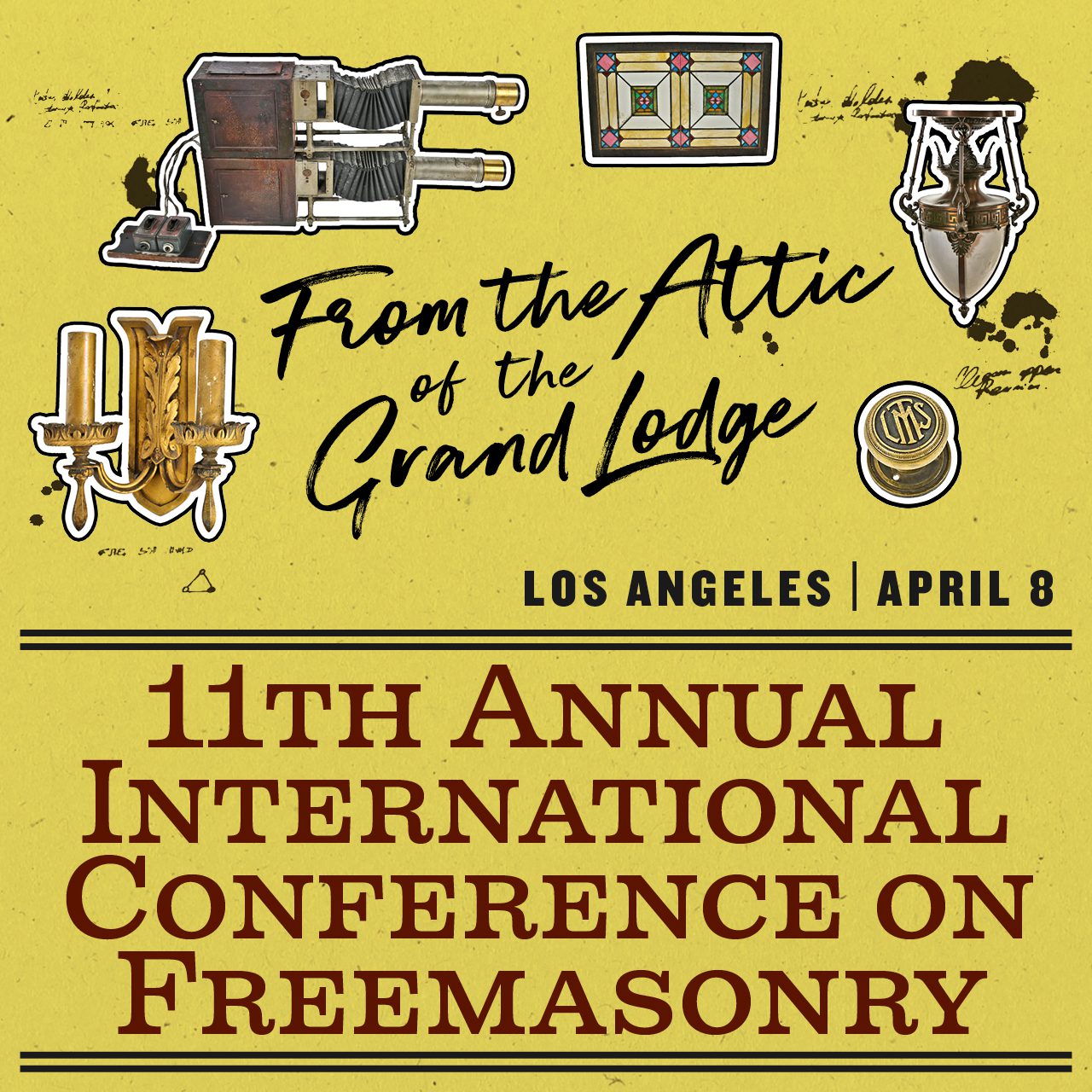
At the International Conference on Freemasonry, Exploring the Treasures in the Lodge Attic
At the 11th International Conference on Freemasonry, expert historians train their sights on the lodge attic.
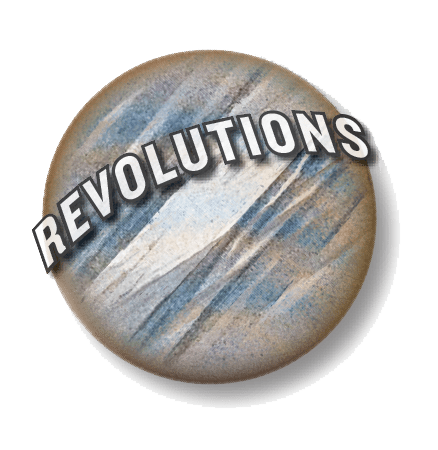
BY TONY GILBERT
It was Tuesday night, just before 7 p.m., when ordinarily members of Golden Gate Speranza Lodge No. 30 would be milling around outside the lodge room on San Francisco’s Taraval Street. Instead, the room was empty. A pile of mail sat unopened on the secretary’s desk. The paper leprechaun decorations in the dining room remained, a reminder of a celebration that never came to pass. On March 16, 2020, Masonry—along with virtually every other part of everyday life—came to a standstill in California as the governor announced historic restrictions on in-person gatherings in an attempt to curb the spread of COVID-19. As the days stretched into weeks and months, lodge rooms remained empty. In a time of social distancing, Masonic lodge business fell to the bottom of what was considered essential work.
It could hardly have come at a worse time for California Masonry, which was on the precipice of posting its first yearly membership gains in more than half a century.
Instead, all new applications and degree conferrals were postponed—indeed all Masonic activity was put on hold. Masonry, as an essentially social pastime, requires face-to-face interaction. Despite the best efforts of lodges to replicate their meetings online, the concern began to grow: Was this the end of Masonry in California?
Three years later, the answer to that question is a resounding no. At the same time, it has in many ways changed. The COVID era has been a unique opportunity for Masons, lodges, and the fraternity as a whole to reconsider what matters to them and meditate on their values. Accordingly, many of their priorities have changed. The lodges that are thriving post-pandemic are, largely, the ones that have adapted to a new reality. Says Douglas Campbell, master of Table Mountain № 124 in Paradise, “it’s a wonderful thing to have to reinvent yourself.”
That’s especially resonant for a fraternity whose central allegory revolves around new beginnings and rebirth. Rather than representing the end of Freemasonry in California, the pandemic and subsequent shutdown have afforded it something like a hard reset—an opportunity to start again. If COVID spelled the death of Freemasonry, it was also its opportunity for a Masonic rebirth.
As an institution, Masonry has been through the cycles of death and rebirth many times. The oft-repeated narrative about a slow and steady decline in lodge membership is both true and incomplete. In California, membership in the fraternity peaked in 1965, when 244,586 members belonged to the Grand Lodge of California. In 2020, that number was 44,586—a loss of precisely 200,000. Nationwide, membership in the fraternity has dropped by roughly 75 percent since 1959, according to NPR.
But Freemasonry is a particularly old tradition, and its late-20th century decline represents only a fraction of that history. In fact, membership has ebbed and flowed many times over the past 300 years. Over the long haul, periods of sharp decline and rapid growth are equally common. Indeed, the popularity of Masonry in the time of Washington and Franklin, in the late 18th century, was followed by a bust and precipitous drop in membership during the height of anti-Masonry in the first half of the 19th century, followed by a boom in the so-called “Golden Age of Fraternalism” only a generation later.
Throughout that history, Masonry has constantly adapted—from the comparatively raw form of the craft practiced in the 18th century, when lodges often met above taverns and helped birth revolutionary fervor, to the more muscular institution that overtook it, manifested in physical form in grand structures like the 333-foot George Washington Masonic National Memorial in Virginia, the life-sized bronze statue of Benjamin Franklin and George Washington outside the ornate Philadelphia Masonic Temple, or in the travertine marble-clad California Masonic Memorial Temple—which opened at the fraternity’s postwar membership peak.
In many ways, the next iteration of Freemasonry is already here, says Blake Green, the current master of Sacramento № 40. Green has a unique perspective on the matter, as he occupies the newly formed role of membership advisor for the Grand Lodge of California, helping guide prospective members to suitable lodges. Amid an overall uptick in membership inquiries since the pandemic, he’s noted the emergence of many new, smaller, and more agile lodges being chartered in recent years, each centered around a shared and narrow vision of itself. Exactly what that is isn’t the same for any two lodges. But each has a foundational vision of what it wants to be.
Elsewhere, he says, many longstanding groups have pivoted their efforts post-COVID toward more community-focused philanthropic pursuits. For others, it’s been an open embrace of more esoteric interests. In each case, he says, those changes represent the first signs of a fraternity-wide rebirth. “As devastating as the pandemic was, I think it gave many people time to really think about what is important to them and what they want out of life,” Green says. “Many of the prospects I’ve spoken to have mentioned having a kind of awakening.”
“It’s a wonderful thing to have to reinvent yourself.”
Douglas Campbell, Table Mountain No. 124
The tension between, on the one hand, Masonry’s constant need to reinvent itself, and on the other, its open embrace of history and tradition is a big part of what makes it so dynamic. Ask any two members to define what Masonry is, and you might hear ten answers. Is it a charity? A spiritual outlet? A system of morality? A dinner club? A service organization? A philosophy? In short, yes—with a dozen asterisks and footnotes and nuances and subtle differences. Masonry has been described by the old chestnut about an enigma wrapped in a mystery inside a riddle. When it comes to reinventing itself, that amorphousness is perhaps its greatest asset.
In his 2018 book The Square and the Tower, author Niall Ferguson credits Freemasonry’s longevity precisely to that ability to adapt. That, he writes, has historically been driven by its decentralization. As a result, Freemasonry has been practically impossible to extinguish. Instead, throughout its various life cycles, it keeps reforming in the image of its members. “Hierarchies housed in high towers have claimed to rule,” he writes, “but often real power has resided in the networks in the town square below.”
Above:
An 1849 print shows the effects of Earth’s tilt in relation to the season as it rotates around the sun.
There’s perhaps no better illustration of Masonic rebirth than in Paradise, California, where in 2018, the Camp Fire destroyed 95 percent of the structures in town, killing 85 people. Amazingly, the stone lodge hall of Table Mountain № 124 survived the blaze. And in the months that followed the fire, when all but 10 percent of the town’s population moved away, the lodge became a beacon to the battered town—one of the last surviving structures, and almost by default, a communal gathering place.
During the prolonged covid shutdown, the few remaining members of the lodge set about repairing the damaged hall—all the while leasing it out to various nonprofit groups and government agencies. In doing so, Campbell says, the very nature of the lodge changed to become more intimately tied to the community around it. “When we stepped forward and went to the schools, when we provided space for community services, for the school dance—the value of those events was bigger here than it would be in a larger or more secure community,” Campbell explains. The need to give back gave the lodge a renewed sense of purpose.
Even within the lodge, Table Mountain emerged as a group open to trying new things. Members experimented for the first time with holding large, outdoor degrees. They tried meeting on weekends. “We reinvented ourselves in a real way,” Campbell says. “I think we’re transforming Masonry.”
“We reinvented ourselves in a real way. I think we’re transforming Masonry.”
Douglas Campbell, Table Mountain No. 124
For Campbell and others in the region, the result has been a new brand of Freemasonry. And it’s already started to draw new members in—and bring some old ones back.
Alan Rellaford is one of them. A volunteer chaplain at Enloe Hospital in Chico, about 15 miles from Paradise, Rellaford had grown up with Masonry for most of his life, back to his initiation in DeMolay at age 13. At 24, he joined Table Mountain № 124. But work, moving, and travel called him away. In 1995, a decade after being initiated, he let his annual membership dues lapse.
That stayed the case for years. But in many ways, he never completely lost touch with Masonry. While Rellaford might not have held a dues card in his wallet in the intervening years, he stayed connected with several friends from the lodge, and espoused the kind of values Masons are charged to demonstrate outside the lodge room. In the aftermath of the fire, Rellaford worked with an interfaith group that assists the suddenly enormous population of homeless and marginally housed people in Chico, providing basic necessities like clothes, water, and the simple dignity of a friendly conversation.
Like so many others, Rellaford was deeply moved by the community’s mobilization—including the lodge’s—throughout the fire and then the pandemic. So in 2021, after a 26-year gap, Rellaford renewed his Masonic affiliation. “I missed the camaraderie, the ritual, the greater connection,” Rellaford says. “It’s truly a fraternal and lifelong bond. It isn’t just a club. We really live those principles.”
Above:
An antique model of the solar system is depicted in an 1849 astronomy print.
Being reborn isn’t a simple thing. It takes updating your entire worldview. For an organization as seeped in spiritual traditions as Freemasonry, that invites a level of soul-searching that, frankly, most other membership groups probably wouldn’t embrace.
But Masonic rebirth practically requires its members to think about reinvention—to constantly hone the rough ashlar into polished stone. Through changing ourselves individually, we can change society, it is thought. Such a person-by-person approach echoes concepts like tikkun olam, or spiritual alchemy, captured in the phrase “change starts with me.”
Put simply, a new era of Freemasonry is reliant on a new kind of Freemason.
What will those Masons look and act like? For a growing number of members, there’s a sense that the humanistic sides of Freemasonry will become more relevant—not less—in an increasingly high-tech world. “We need to work on our inner lives more than anything,” says Andy Stock, of San Francisco № 120. Stock, who practices “passage meditation,” which involves memorizing sacred texts from a variety of belief systems, invokes the Indian principle of ahimsa, or nonviolence toward other living things. “Brother John Lewis practiced ahimsa and passive resistance. I’m hoping that it’s an evolutionary necessity to move the human race toward a consciousness that understands and practices that,” he says.
Of course, Masonry incorporates ideas from many diverse systems. But the kind of open-minded philosophic inquiry that Masonry promotes, while it may seem anachronistic in such a secular and tech-focused world, may come to define it in the near future. That is, the very concepts of philosophy and logic are suddenly relevant insofar as they relate to technological advances like artificial intelligence, machine learning, and other sophisticated tech.
Could Freemasonry find a new relevance in an age in which people primarily meet online—or in the so-called metaverse? As society debates the moral framework on which AI systems are built, could the Masonic lodge stand out as a privileged space for those kinds of discussions?
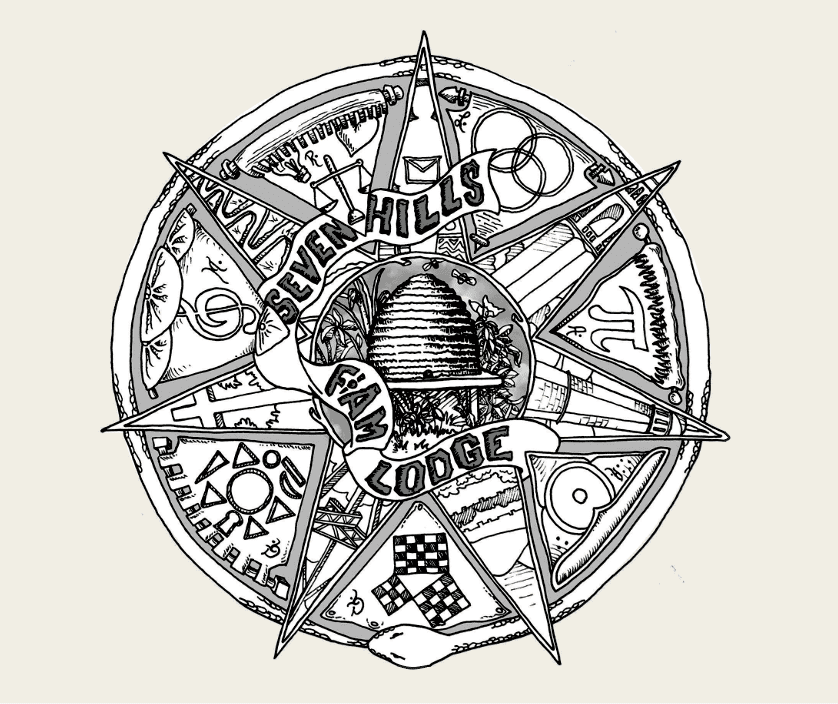
Masonry offers an alternative path for the curious seeker, with answers not found on a search engine; where physical handshakes replace digital ones, passwords are whispered, not typed, and interactive “morality plays” resonate more deeply than any YouTube video. Perhaps the path forward for Masonry’s next cycle is in remaining stubbornly connected to its past—in keeping alive the art of memorization.
Mark McNee is among those who see opportunity in uncertainty. In January 2023, McNee was installed as the second master of the newly chartered Seven Hills Lodge № 881. “It’s a lodge of experimentation,” McNee explains. In San Francisco, a place known for startups, Seven Hills includes members with strong ideas about how best to interact as a lodge. The group encourages gregarious socializing, dialectical discussion, hearty fireside chats, and often-boisterous cocktail hours. “To do what we really wanted, we needed to start our own lodge,” McNee adds. Removing the weight of tradition gave the lodge the freedom to evolve as it saw fit. “Nothing has been done before when you start something new,” he says.
One of the first projects the lodge undertook was in collaborating on a logo that would capture the lodge’s ethos and identity. Member Daniel Stoner, an art director by trade, was tasked with capturing the crest. His design incorporates a smattering of hermetic symbols and local references, including to the eponymous seven hills of San Francisco. The imagery is encircled by an ouroboros—a snake eating its own tail—a symbol which has long been associated with rebirth.
Stoner explains the symbol as befitting the new lodge, which grew out of several other Bay Area outfits. His logo was meant to pay homage to the Masonic tracing boards of the 19th century while alluding to the reinvention and evolution at the heart of the group’s founding. As both the newest lodge in the state and, perhaps, a harbinger of what’s to come, it’s particularly appropriate.
That’s the heady explanation. But as with Freemasonry more generally, there’s also another, more aesthetic appeal. “That concept of a perpetual cycle of renewal really resonated with me,” Stoner says. Then, pausing a beat, he fills in the blank. “Plus, you know, snakes are just really cool.”
Above:
A brass and mahogany planetary model from the late 1700s.
ILLUSTRATIONS BY:
Daniel Stoner
Alamy

At the 11th International Conference on Freemasonry, expert historians train their sights on the lodge attic.
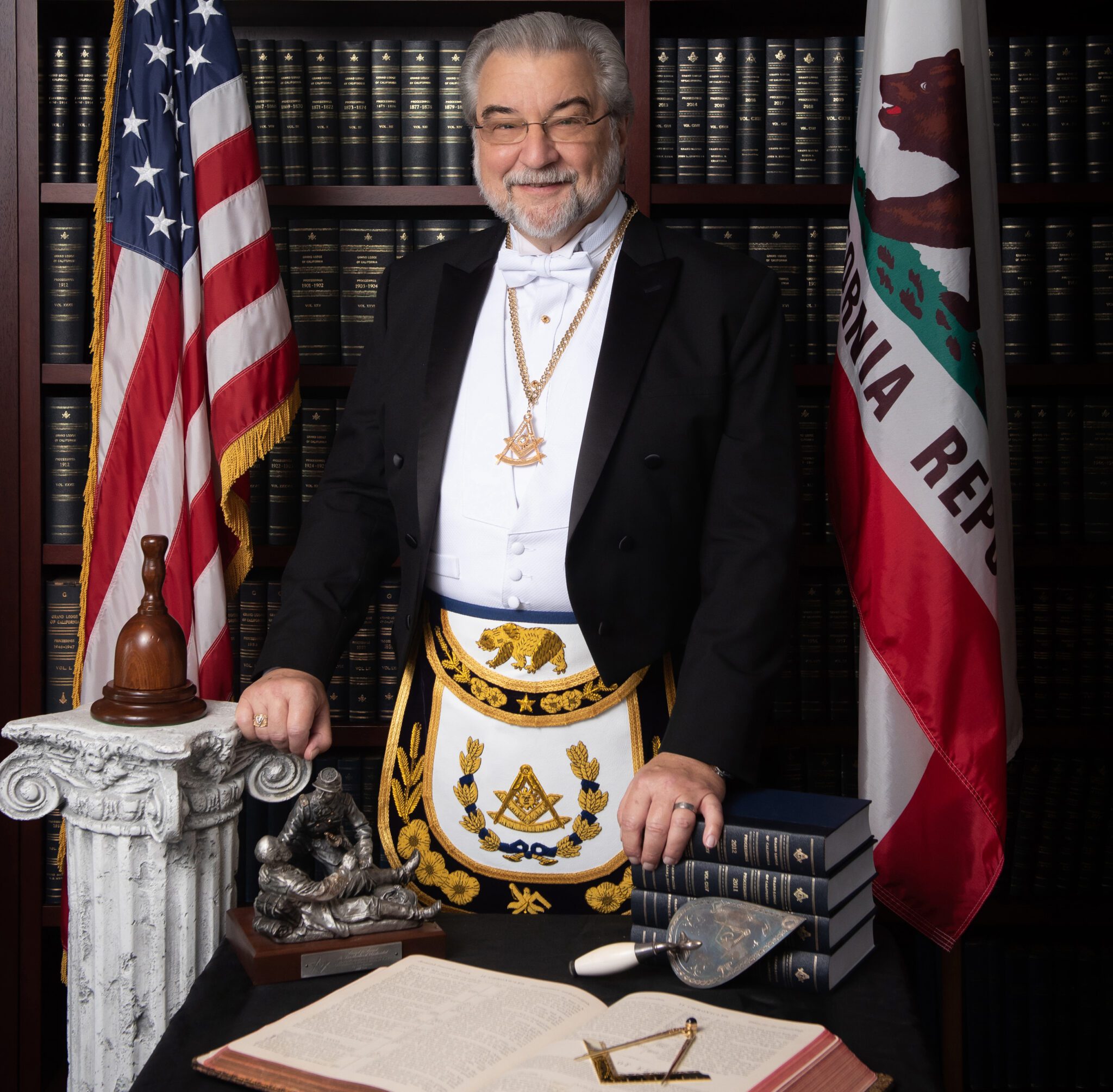
Grand Master of Masons of California Randall L. Brill explains how now’s the time for Freemasonry to begin again in California.
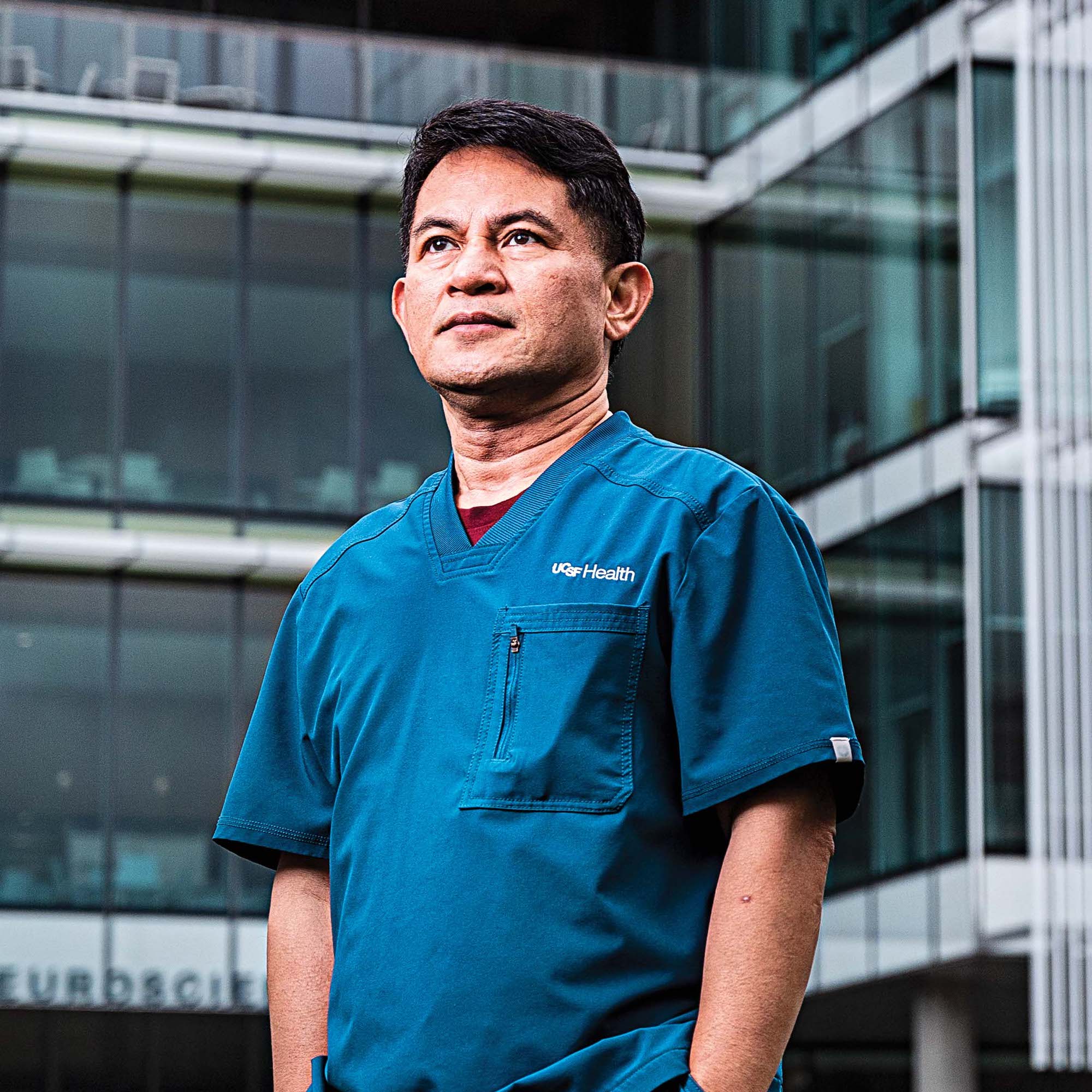
A former priest on what his world travels have taught him and how Masonic relief ties it all together.